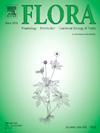揭示红枫属植物的叶结构特征。(桃金娘科)用于该属的分类
IF 1.8
4区 生物学
Q3 ECOLOGY
引用次数: 0
摘要
以解剖学为重点的叶片结构研究有助于解决桃金娘科的分类问题,表明它们是更好地了解鲜为人知的类群的一种有前途的方法。在分类上划分不育的Campomanesia标本是困难的,尽管这个组有叶片结构特征,在文献中很少探索。本研究的目的是描述海芋属植物的叶片结构特征,并确定其成为分层分类群的潜力。叶的结构在种之间变化:次生脉是外生的或延生的,具有交替到不规则的排列;第三脉是顺流互生的、混合的或对生的。自由结束的小脉范围从不分枝到高度分枝(树突状),提供潜在的特征来区分基于脉复杂性的物种。叶背侧,下气孔,中间维管束形成一个连续的拱形,末端向上或朝向中心。这种模式表明,结构上的适应可能在进化枝中保守,因此可能对分类分组有用。叶柄有维管弓,这些维管弓要么内陷,要么指向中心,这些变化,以及维管弓的连续性或不连续性,为种界提供了额外的解剖学标记。侧静脉有鞘延伸,排列的分泌腔可出现在两个表皮表面或仅在背面。分泌腔的分布已被证明是桃金娘科物种分化的一个有用特征,这在Campomanesia中得到了证实。这些发现表明,叶片结构特征具有一致性和多样性,足以作为Campomanesia物种划分的可靠特征。本文章由计算机程序翻译,如有差异,请以英文原文为准。
Revealing leaf structure characters of taxa of Campomanesia Ruiz & Pav. (Myrtaceae) to use in the taxonomy of the genus
Leaf structure studies focused on anatomy have helped resolve taxonomic problems in Myrtaceae, demonstrating they are a promising method to better understand poorly known groups. Taxonomically delimiting sterile specimens of Campomanesia is difficult, although this group has leaf structure characters that are little explored in the literature. The present study had the objectives of describing the leaf structure characters of Campomanesia and determining their potential to delaminate taxa. The leaf architecture varied among the species: secondary veins are excurrent or decurrent, with alternate to irregular arrangements; and tertiary veins are percurrent alternate, mixed, or opposite. Freely ending veinlets range from unbranched to highly branched (dendritic), offering potential characters to separate species based on venation complexity. The leaves are dorsiventral and hypostomatic, with a median vascular bundle forming a continuous arch with ends that turn upward or toward the center. This pattern suggests structural adaptations that may be conserved within clades and, thus, might be useful for taxonomic grouping. Petioles have vascular arches that are either invaginated or directed towards the center, and these variations, along with the continuity or discontinuity of the arch, provide additional anatomical markers for species delimitation. The lateral veins have sheath extensions, and aligned secretory cavities can occur in both epidermis surfaces or only in the abaxial surface. The distribution of secretory cavities has proven to be a useful trait for species differentiation in Myrtaceae, which is corroborated here for Campomanesia. These findings demonstrate that leaf structural features are consistent and diverse enough to serve as reliable characters for species delimitation within Campomanesia.
求助全文
通过发布文献求助,成功后即可免费获取论文全文。
去求助
来源期刊

Flora
生物-植物科学
CiteScore
3.30
自引率
10.50%
发文量
130
审稿时长
54 days
期刊介绍:
FLORA publishes original contributions and review articles on plant structure (morphology and anatomy), plant distribution (incl. phylogeography) and plant functional ecology (ecophysiology, population ecology and population genetics, organismic interactions, community ecology, ecosystem ecology). Manuscripts (both original and review articles) on a single topic can be compiled in Special Issues, for which suggestions are welcome.
FLORA, the scientific botanical journal with the longest uninterrupted publication sequence (since 1818), considers manuscripts in the above areas which appeal a broad scientific and international readership. Manuscripts focused on floristics and vegetation science will only be considered if they exceed the pure descriptive approach and have relevance for interpreting plant morphology, distribution or ecology. Manuscripts whose content is restricted to purely systematic and nomenclature matters, to geobotanical aspects of only local interest, to pure applications in agri-, horti- or silviculture and pharmacology, and experimental studies dealing exclusively with investigations at the cellular and subcellular level will not be accepted. Manuscripts dealing with comparative and evolutionary aspects of morphology, anatomy and development are welcome.
 求助内容:
求助内容: 应助结果提醒方式:
应助结果提醒方式:


